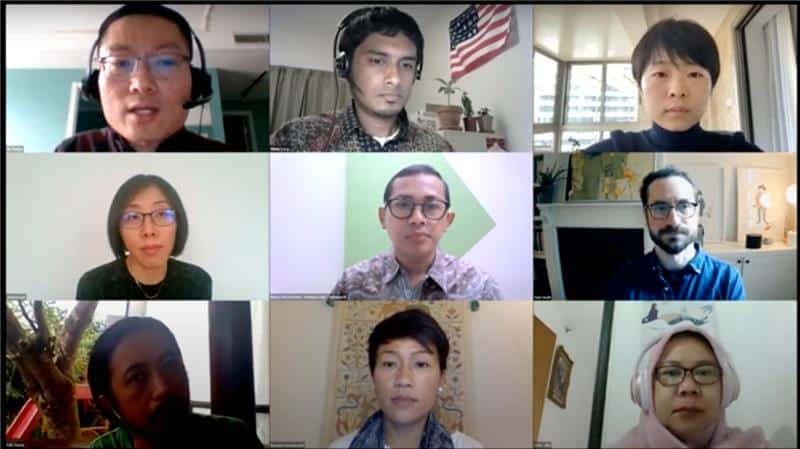Attending an online workshop, Indonesian editor and writer Sapariah Saturi joins wearing all black. It’s for a reason, she says: “I am wearing all black to reflect the growing environmental threats in Indonesia.”
She goes on to share a report by her outlet, Mongabay Indonesia, about how the residents of the Lamobolo Hamlet in North Morowali, Central Sulawesi, occupied the regional representative’s office to protest government inaction on the pollution caused by the exhaust fumes from a nearby smelter plant. The plant is owned by a consortium of companies, with Chinese company Jinsheng Mining owning most shares.
“We only covered this briefly. If it weren’t for the pandemic, we would have sent a journalist to cover this [in more detail]. But the condition of the location is a challenge of its own for journalists,” says Saturi. Traveling to Central Morowali takes days, not to mention funding, she adds.
Saturi was among 57 participants who attended the online workshop, which took place over two days in March. The training, which was supported by the Ford Foundation and co-hosted by EJN, China Dialogue and the Society of Indonesian Environmental Journalists, focused on how to cover Chinese investments and their social and environmental impacts in Indonesia.
The workshop brought together Indonesian editors, journalists and civil society groups to discuss the issues related to Chinese investments in Indonesia – of which there are many. According to data from Indonesia’s investment coordinating board (BKPM), China accounted for 17% of foreign direct investment in 2019 in Indonesia, the second largest after Singapore.
The workshop focused on China, mainly because there’s been an increase in trade and a strengthening of bilateral relations between the two nations in the last decade, driven by China’s competitive advantage in technology and financing and Indonesia’s big push for infrastructure development and spending.
“The Jokowi administration was eager to push for public-private partnership, and that brought China into the picture,” says Jessica Liao from the University of North Carolina, an expert on Chinese foreign policy, who shared her research during the workshop on the political economy of the Chinese investment, particularly the Belt and Road Initiative in Southeast Asia.
Adi Renaldi, a multimedia freelance journalist who recently reported about Indonesia’s reliance on coal spoke during the workshop to share the challenges he faced while reporting.
“There’s a lack of transparency from the government,” he explains. “I couldn’t access some documents, particularly from state utility agency, PLN, and its subsidiary, Indonesia Power. And also a lack of information on health impacts.”
However, where data is available, Renaldi learned that in Banten, home to 19 coal-fired power plants – the most in Indonesia – respiratory infections are the most common disease in the area. More specific data on environmental impacts from these coal plants is hard to find, he adds.
Freelance journalist Fira Abdurachman, another workshop attendee, has published reports on the Belt and Road Initiative and plastic imports. She shared several challenges she’s faced in reporting on these issues during the workshop.
“The government stated that they have open data. But the fact is it’s hard to get it. It’s difficult for us to produce an accurate and comprehensive report when access to data is minimal.”
—Freelance journalist Fira Abdurachman
Freelance journalists also don’t always have the means or authority to visit remote areas where environmental injustices are occurring, Abdurachman added, especially when local authorities refuse to grant them access to project sites or key areas.
Lu Lu Ning Hui, a senior journalist from Nitium Media, a Hong Kong-based in-depth media outlet that speaks to Chinese audiences in mainland China, Taiwan and abroad, underscored the importance of cross-border collaboration, while also acknowledging how Covid-19 has changed the landscape.
“Get help from Chinese journalists, try to share opinions and see where things can be linked,” Hui said, giving some advice to Indonesian workshop participants.
Agoeng Widjaja, a journalist and senior editor at the Indonesian outlet Tempo, said that although many outlets report on the economic impacts first, Tempo tries to focus on the social and environmental ones using the project’s environmental impact assessment (EIA).
“Media never test these EIAs independently. This is the challenge we face, because journalists have difficulty accessing data,” Widjaja says. “That media or journalist will then not be able to conduct independent research.”
Workshop attendees also discussed the role of non-governmental organizations (NGOs) in this conversation. Widjaja said the current collaboration model between journalists and NGOs needs to change – and his outlet Tempo is already working on a project to bring NGOs, academics and journalists together from the start.
Renaldi agreed: “I believe in collaboration work between environmental organizations, media, activists, to uncover any environmental damages done by the government.”
Overall, the workshop was an opportunity for journalists, editors and those in civil society to identify knowledge gaps in covering these issues, share ideas for collaboration and discuss how to mitigate the challenges journalists are currently facing on the ground.
